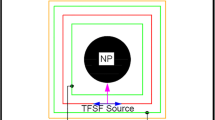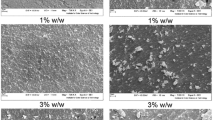Abstract
Radiative cooling can achieve cooling effect without consuming any energy by delivering energy into outer space (3 K) through “atmospheric window” (8–13 μm). Conventional radiative cooling coating with multi-layer structure was severely restricted during application due to its complex preparation process and high cost. In this study, a single-layer radiative cooling coating with mixture of TiO2 particles and SiO2 particles was proposed. The algorithm for calculating the radiative properties of the multi-particle system was developed. Monte Carlo ray-tracing method combined with that algorithm was used to solve the radiative transfer equation (RTE) of the single-layer radiative cooling coating with mixture of TiO2 particles and SiO2 particles. The effects of particle diameter, volume fraction and coating thickness on radiative cooling performance were analyzed to obtain the best radiative cooling performance. The numerical results indicated that the average reflectivity of the single-layer radiative cooling coating with mixture of TiO2 particles and SiO2 particles in the solar spectrum can reach 95.6%, while and the average emissivity in the “atmospheric window” spectrum can reach 94.9% without additional silver-reflectance layer. The average reflectivity in the solar spectrum and average emissivity in the “atmospheric window” spectrum of the single-layer radiative cooling coating with mixture of TiO2 particles and SiO2 particles can increase 4.6% and 4.8% compared to the double-layer radiative cooling coating. This numerical research results can provide a theoretical guidance for design and optimization of single-layer radiative cooling coatings containing mixed nanoparticles.
Similar content being viewed by others

References
Li L, Li Y, Yu H, et al. A feedforward-feedback hybrid control strategy towards ordered utilization of concentrating solar energy. Renew Energy, 2020, 154: 305–315
Mandal J, Fu Y, Overvig A C, et al. Hierarchically porous polymer coatings for highly efficient passive daytime radiative cooling. Science, 2018, 362: 315–319
Zhao D, Yin X, Xu J, et al. Radiative sky cooling-assisted thermoelectric cooling system for building applications. Energy, 2020, 190: 116322
Liu J, Zhou Z, Zhang D, et al. Research on the performance of radiative cooling and solar heating coupling module to direct control indoor temperature. Energy Convers Manage, 2020, 205: 112395
Jeong S Y, Tso C Y, Ha J, et al. Field investigation of a photonic multi-layered TiO2 passive radiative cooler in sub-tropical climate. Renew Energy, 2020, 146: 44–55
Guo C L, Liu C, Jiao S K, et al. Introducing optical fiber as internal light source into direct absorption solar collector for enhancing photothermal conversion performance of MWCNT-H2O nanofluids. Appl Therm Eng, 2020, 173: 115207
Zhou Y, Zheng S, Zhang G. Machine learning-based optimal design of a phase change material integrated renewable system with on-site PV, radiative cooling and hybrid ventilations-study of modelling and application in five climatic regions. Energy, 2020, 192: 116608
Hu M, Zhao B, Ao X, et al. Performance assessment of a trifunctional system integrating solar PV, solar thermal, and radiative sky cooling. Appl Energy, 2020, 260: 114167
Hu M, Zhao B, Ao X, et al. Field investigation of a hybrid photovoltaic-photothermic-radiative cooling system. Appl Energy, 2018, 231: 288–300
Li M, Coimbra C F M. On the effective spectral emissivity of clear skies and the radiative cooling potential of selectively designed materials. Int J Heat Mass Transfer, 2019, 135: 1053–1062
Zhao B, Hu M, Ao X, et al. Performance evaluation of daytime radiative cooling under different clear sky conditions. Appl Thermal Eng, 2019, 155: 660–666
Bergman T L. Active daytime radiative cooling using spectrally selective surfaces for air conditioning and refrigeration systems. Sol Energy, 2018, 174: 16–23
Zhai Y, Ma Y, David S N, et al. Scalable-manufactured randomized glass-polymer hybrid metamaterial for daytime radiative cooling. Science, 2017, 355: 1062–1066
Zheng S, Yang Y, Zhou H. The effect of different HITRAN databases on the accuracy of the SNB and SNBCK calculations. Int J Heat Mass Transfer, 2019, 129: 1232–1241
Fan J, Fu C, Fu T. Yttria-stabilized zirconia coating for passive daytime radiative cooling in humid environment. Appl Thermal Eng, 2020, 165: 114585
Zou Y, Wang Y, Zhang H, et al. Al2O3/reduced graphene oxide double-layer radiative coating for efficient heat dissipation. Mater Des, 2018, 157: 130–140
Cheng Q, Chai J, Zhang Z. Investigation of double-layer coating pigmented with CuO particles of different concentrations on aesthetic and thermal aspects. Int J Thermal Sci, 2016, 105: 36–44
Gentle A R, Smith G B. Radiative heat pumping from the Earth using surface phonon resonant nanoparticles. Nano Lett, 2010, 10: 373–379
Peoples J, Li X, Lv Y, et al. A strategy of hierarchical particle sizes in nanoparticle composite for enhancing solar reflection. Int J Heat Mass Transfer, 2019, 131: 487–494
Xu Z, Li N, Liu D, et al. A new crystal Mg11(HPO3)8(OH)6 for daytime radiative cooling. Sol Energy Mater Sol Cells, 2018, 185: 536–541
Yang P, Chen C, Zhang Z M. A dual-layer structure with record-high solar reflectance for daytime radiative cooling. Sol Energy, 2018, 169: 316–324
Zhao X, He X D, Sun Y, et al. Carbon nanotubes doped SiO2/SiO2-PbO double layer high emissivity coating. Mater Lett, 2011, 65: 2592–2594
Wang X, He Y, Hu Y, et al. Photothermal-conversion-enhanced photocatalytic activity of flower-like CuS superparticles under solar light irradiation. Sol Energy, 2018, 170: 586–593
Liu C, Bian J, Zhang G, et al. Influence of optical parameters on thermal and optical performance of multi-layer glazed roof filled with PCM. Appl Thermal Eng, 2018, 134: 615–625
Huang Z, Ruan X. Nanoparticle embedded double-layer coating for daytime radiative cooling. Int J Heat Mass Transfer, 2017, 104: 890–896
Mahadik D B, Gujjar S, Gouda G M, et al. Double layer SiO2/Al2O3 high emissivity coatings on stainless steel substrates using simple spray deposition system. Appl Surf Sci, 2014, 299: 6–11
Bao H, Yan C, Wang B, et al. Double-layer nanoparticle-based coatings for efficient terrestrial radiative cooling. Sol Energy Mater Sol Cells, 2017, 168: 78–84
Wang C, Zhang Y, Hou H, et al. Entropy production diagnostic analysis of energy consumption for cavitation flow in a two-stage LNG cryogenic submerged pump. Int J Heat Mass Transfer, 2019, 129: 342–356
Song J, Qin J, Qu J, et al. The effects of particle size distribution on the optical properties of titanium dioxide rutile pigments and their applications in cool non-white coatings. Sol Energy Mater Sol Cells, 2014, 130: 42–50
Chai J, Cheng Q, Si M, et al. Numerical simulation of white double-layer coating with different submicron particles on the spectral reflectance. J Quantitative Spectr Radiative Transfer, 2017, 189: 176–180
Baneshi M, Maruyama S, Komiya A. The effects of TiO2 pigmented coatings characteristics on temperature and brightness of a coated black substrate. Sol Energy, 2012, 86: 200–207
Cheng Z, Wang F, Wang H, et al. Effect of embedded polydisperse glass microspheres on radiative cooling of a coating. Int J Thermal Sci, 2019, 140: 358–367
Zheng S, Liang W, Chu H, et al. Effects of radiation reabsorption of C1–C6 hydrocarbon flames at normal and elevated pressures. Fuel, 2020, 266: 117061
Modest M. Radiative Heat Transfer. 3rd ed. San Diego: Academic Press, 2013
Dombrovsky L A. Radiation Heat Transfer in Disperse Systems. New York: Begell House, 1996
Wang F Q, Ma L X, Cheng Z M, et al. Radiative heat transfer in solar thermochemical particle reactor: A comprehensive review. Renew Sust Energ Rev 2017, 73: 935–949
Palik E D. Handbook of Optical Constants of Solids. San Diego: Academic Press, 1985
Dombrovsky L A. Modeling of thermal radiation of polymer coating containing hollow microspheres. High Temp, 2005, 43: 247–258
Sun Y, Zheng S, Jiang B, et al. One-dimensional P1 method for gas radiation heat transfer in spherical geometry. Int J Heat Mass Transfer, 2019, 145: 118777
Li Y, Chen H W, Xia X L, et al. Prediction of high-temperature radiative properties of copper, nickel, zirconia, and alumina foams. Int J Heat Mass Transfer, 2020, 148: 119154
Wen S, Qi H, Li Y, et al. An on-line extended Kalman filtering technique for reconstructing the transient heat flux and temperature field in two-dimensional participating media. Int J Thermal Sci, 2020, 148: 106069
Wang F, Shuai Y, Tan H, et al. Thermal performance analysis of porous media receiver with concentrated solar irradiation. Int J Heat Mass Transfer, 2013, 62: 247–254
Raman A P, Anoma M A, Zhu L, et al. Passive radiative cooling below ambient air temperature under direct sunlight. Nature, 2014, 515: 540–544
Mao Q, Zhang Y. Thermal energy storage performance of a three-PCM cascade tank in a high-temperature packed bed system. Renew Energy, 2020, 152: 110–119
Arıcı M, Bilgin F, Nižetić S, et al. PCM integrated to external building walls: An optimization study on maximum activation of latent heat. Appl Thermal Eng, 2020, 165: 114560
Author information
Authors and Affiliations
Corresponding author
Additional information
This work was supported by the China National Key Research and Development Plan Project (Grant No. 2018YFA0702300), the National Natural Science Foundation of China (Grant No. 51676061) and the Taishan Scholars of Shandong Proviance (Grant No. tsqn201812105). The authors thank Prof. Jianyu Tan and Dr. Lanxin Ma for the basic code. The authors thank Dr. Shengpeng Hu for materials characterization and useful discussion.
Rights and permissions
About this article
Cite this article
Cheng, Z., Shuai, Y., Gong, D. et al. Optical properties and cooling performance analyses of single-layer radiative cooling coating with mixture of TiO2 particles and SiO2 particles. Sci. China Technol. Sci. 64, 1017–1029 (2021). https://doi.org/10.1007/s11431-020-1586-9
Received:
Accepted:
Published:
Issue Date:
DOI: https://doi.org/10.1007/s11431-020-1586-9



